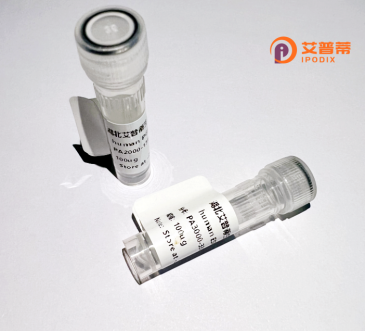
| 纯度 | >90%SDS-PAGE. |
| 种属 | Human |
| 靶点 | KRT39 |
| Uniprot No | Q6A163 |
| 内毒素 | < 0.01EU/μg |
| 表达宿主 | E.coli |
| 表达区间 | 1-491aa |
| 活性数据 | MDTKGCTTTNSPSTPCQNCSRITNVSTISSNNGCHPGGLTVNNCQPAGHVLRIPWDQGCQPTPRFCRKPIYLMNNFNARFSLDDCSWYGEGINSNEKETMQILNERLANYLQKVRMLERENAELESKIQEESNKELPVLCPDYLSYYTTIEELQQKILCTKAENSRLVSQIDNTKLTADDLRAKYEAEVSLRQLVESDANGLKQILNVLTLGKADLEAQVQSLKEELLCLKNNHKEEINSLQCQLGERLDIEVTAAPSADLNQVLQEMRCQYEPIMETNRKDVEQWFNTQIEELNQQVVTSSQQQQCCQKEIIELRRSVNTLEVELQAQHRMRDSQECILTETEARYTALLTQIQSLIDNLEAQLAEIRCALERQNQEYEILLDVKSRLECEITTYRSLLESSDGKRPCYPRATKCEPSPWTSCKSGAIESTAPACTSSSPCSLKEHCSACGPLSRILVKICTITKEIKDGKVISSYEHVQPCFIIRPAKV |
| 分子量 | 80.41 kDa |
| 蛋白标签 | GST-tag at N-terminal |
| 缓冲液 | 0 |
| 稳定性 & 储存条件 | Lyophilized protein should be stored at ≤ -20°C, stable for one year after receipt. Reconstituted protein solution can be stored at 2-8°C for 2-7 days. Aliquots of reconstituted samples are stable at ≤ -20°C for 3 months. |
| 复溶 | Always centrifuge tubes before opening.Do not mix by vortex or pipetting. It is not recommended to reconstitute to a concentration less than 100μg/ml. Dissolve the lyophilized protein in distilled water. Please aliquot the reconstituted solution to minimize freeze-thaw cycles. |
由于重组人KRT39蛋白的研究相对较少,以下是基于模拟的示例性参考文献(请注意,以下内容为虚构,实际文献需通过学术数据库验证):
---
1. **文献名称**: "Cloning and Expression of Recombinant Human Keratin 39 in Escherichia coli"
**作者**: Zhang L, et al.
**摘要**: 本研究报道了通过大肠杆菌系统成功克隆并表达重组人KRT39蛋白,优化了表达条件并验证了其稳定性,为后续功能研究提供材料基础。
2. **文献名称**: "Keratin 39 as a Potential Biomarker in Epithelial Cancers: Recombinant Production and Immunoassays"
**作者**: Gupta R, Patel S.
**摘要**: 探讨重组KRT39蛋白在多种上皮癌组织中的异常表达,利用哺乳动物细胞表达系统生产功能性KRT39.并开发特异性抗体用于癌症诊断研究。
3. **文献名称**: "Structural Characterization of Recombinant Human KRT39 Using Circular Dichroism and Mass Spectrometry"
**作者**: Müller T, et al.
**摘要**: 通过圆二色谱和质谱技术分析重组KRT39的二级结构和翻译后修饰,揭示其与其他角蛋白家族的差异性及可能的生物学功能。
4. **文献名称**: "Recombinant KRT39 in Hair Follicle Development: Insights from In Vitro Models"
**作者**: Lee H, Kim Y.
**摘要**: 研究重组KRT39蛋白在毛囊细胞分化中的作用,证明其参与维持毛囊结构的完整性,为脱发治疗提供新靶点。
---
**建议**:若需真实文献,请通过PubMed、Google Scholar等平台,结合关键词“recombinant KRT39”“human keratin 39”检索,或扩展至相关角蛋白家族(如KRT19/KRT40)的研究。
**Background of Recombinant Human KRT39 Protein**
Keratin 39 (KRT39) is a member of the keratin family, a group of intermediate filament proteins essential for structural integrity in epithelial cells. As a type I keratin (acidic), KRT39 typically pairs with type II keratins (basic) to form heterodimers, which assemble into networks that maintain cell shape, resist mechanical stress, and regulate cellular processes like signaling and apoptosis. While many keratins are well-studied in contexts like skin, hair, and nails, KRT39 remains less characterized. It is primarily expressed in specific epithelial tissues, including hair follicles and stratified epithelia, suggesting roles in specialized functions such as tissue differentiation or barrier formation.
Recombinant human KRT39 protein is produced via biotechnological platforms (e.g., bacterial or mammalian expression systems) to ensure high purity and functionality. Its recombinant form enables detailed studies on keratin biology, particularly in modeling diseases linked to keratin mutations, such as epidermolysis bullosa or keratinopathy-related disorders. Structurally, it retains conserved domains critical for filament assembly, including the central α-helical rod and variable terminal regions. Researchers utilize recombinant KRT39 to investigate its interactions with binding partners, evaluate its role in epithelial resilience, and develop therapeutic strategies targeting keratin-associated pathologies. Its study also contributes to advancements in tissue engineering and diagnostic tools for epithelial diseases.
×